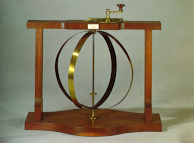
34.8 x 12.5 x 38.2
Brass, iron and wood
CAT. 1824 : E.II.45
Dois circulos de latão, que se cortão em angulo recto atravessados por um varão de ferro, que tem no cimo um carrete, cujus dentes entrão nos d'uma roda dentada, que se poem em movimento por uma manivella. Tudo isto está arranjado n'uma armacção de pao vinhatico. Serve este apparelho para mos-trar, que a força centrifuga é maior no equador do que nos polos, e d'alguma forma mostra o que sucederia ao globo terraqueo na sua solidificação, quando tomou a forma de spheroide achatada nos polos.
Two brass circles, which cross at right angles, traversed by an iron rod that has a bobbin on top whose notches enter in those of a notched wheel, which are coaxed into movement by a crank. All of this is set on a vine wood frame. This apparatus is used to show that the centrifugal force is greater at the equator than at the poles and in a way shows what would happen to the terraqueous globe at its solidification when it took the shape of a flattened spheroid at the poles.
This apparatus consists essentially of two circular metal blades. The planes defined by them intersect, forming within the two a 90º angle. The blades are fixed on a vertical axis by their heighest points. This axle goes through an orifice opened in each of the blades at diametrically opposite points to the fixed points. Some centimetres above this point there is a brass buffer, placed on the axle of the assemblage. This axle, after crossing the orifice on a wooden horizontal cross-beam, ends in a small notched wheel whose notches gear into the notches of a larger wheel. This one is mounted on the same cross-beam and is put into action by means of a crank.
The blades deform when rotating, acquiring the form of an ellipse. This deformation is accentuated when the angular speed increases, until the bottom area of the intersection of the blades, crossed by the vertical axle, moves to the buffer.
It is observed that all points of the blades move, at each moment, at the same angular speed drawing circular trajectories with different radii of curvature. If the mass of a small portion of blade at distance r from the axle of rotation is designated by m, then the intensity of the force that should be applied to maintain a circular trajectory, is given by the relation F = mw2 r, w being the angular speed. This force, which must have a perpendicular direction in relation to the circular trajectory described by the portion of the blade under study, and point to its centre of curvature, is the centripetal force necessary to maintain a circular trajectory. In this case this force is reached as a consequence of the elastic distortion of the blade. The points that make trajectories with the larger curved radius being those of the equator, the force needed to maintain their state of movement is more intense for points close to this area of the blade than it would be for points close the poles. The elastic distortion is greater in that case.
With this device it was possible for the teacher to simulate the deformation of the Earth during a lesson, and to relate this to its rotational motion.
This apparatus is signed by Jacob Bernard Haas.